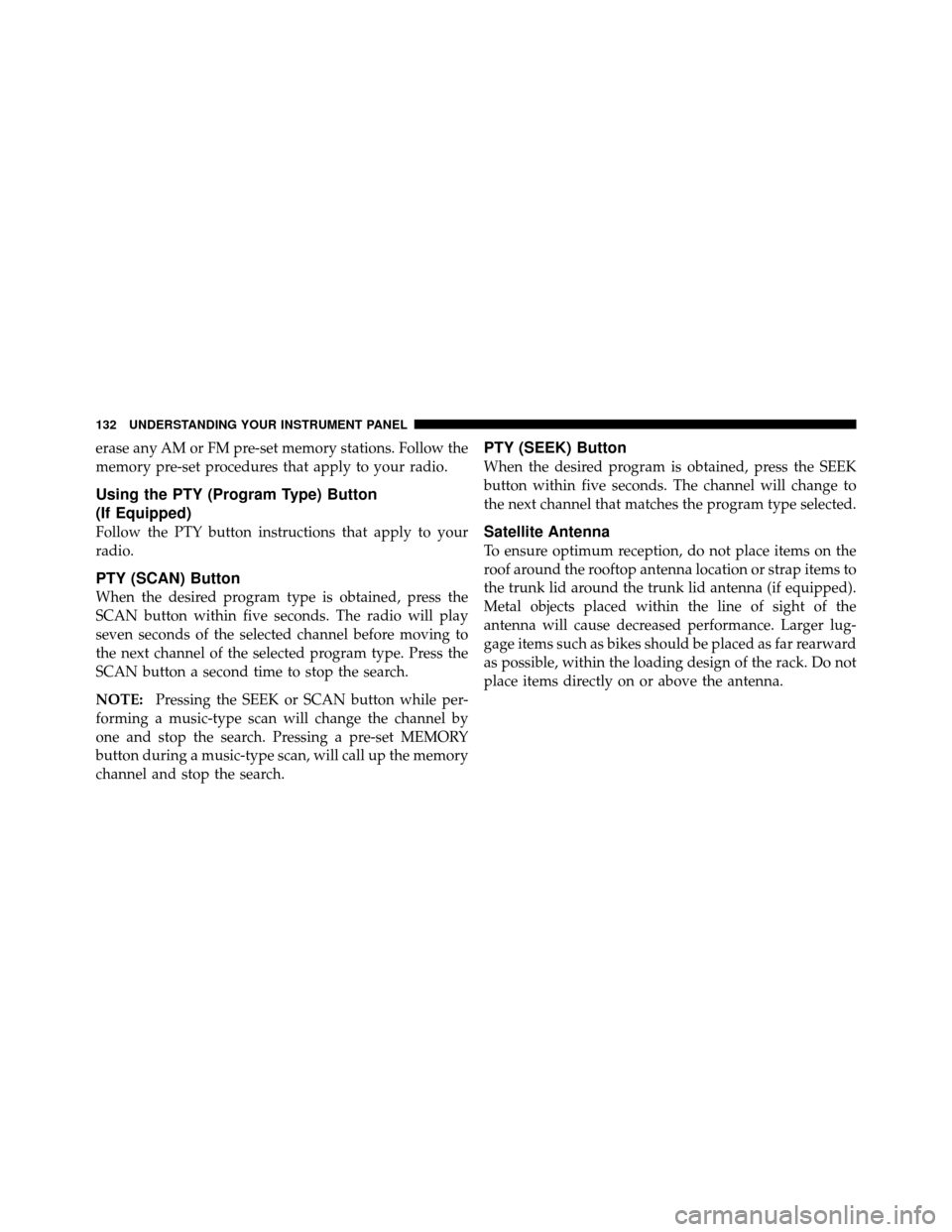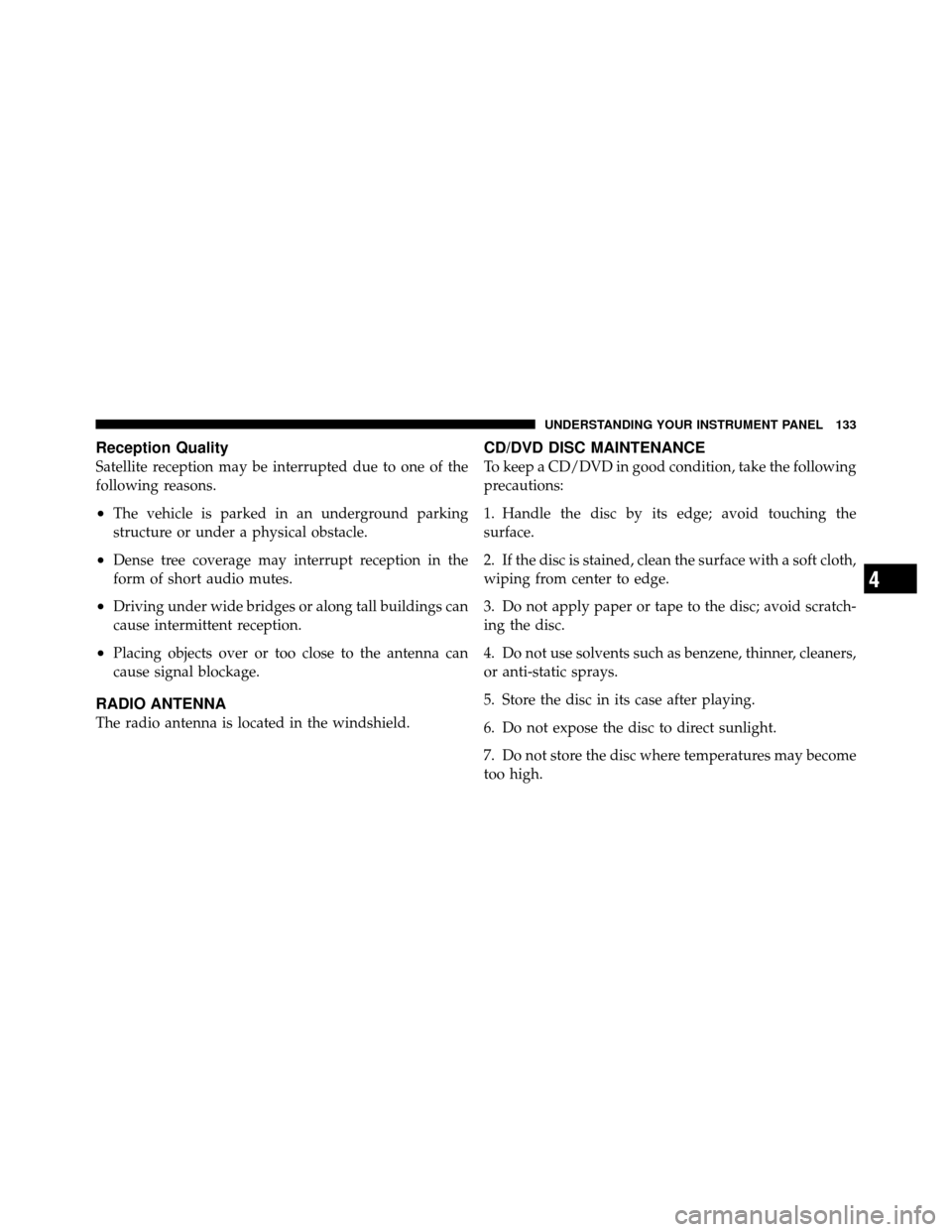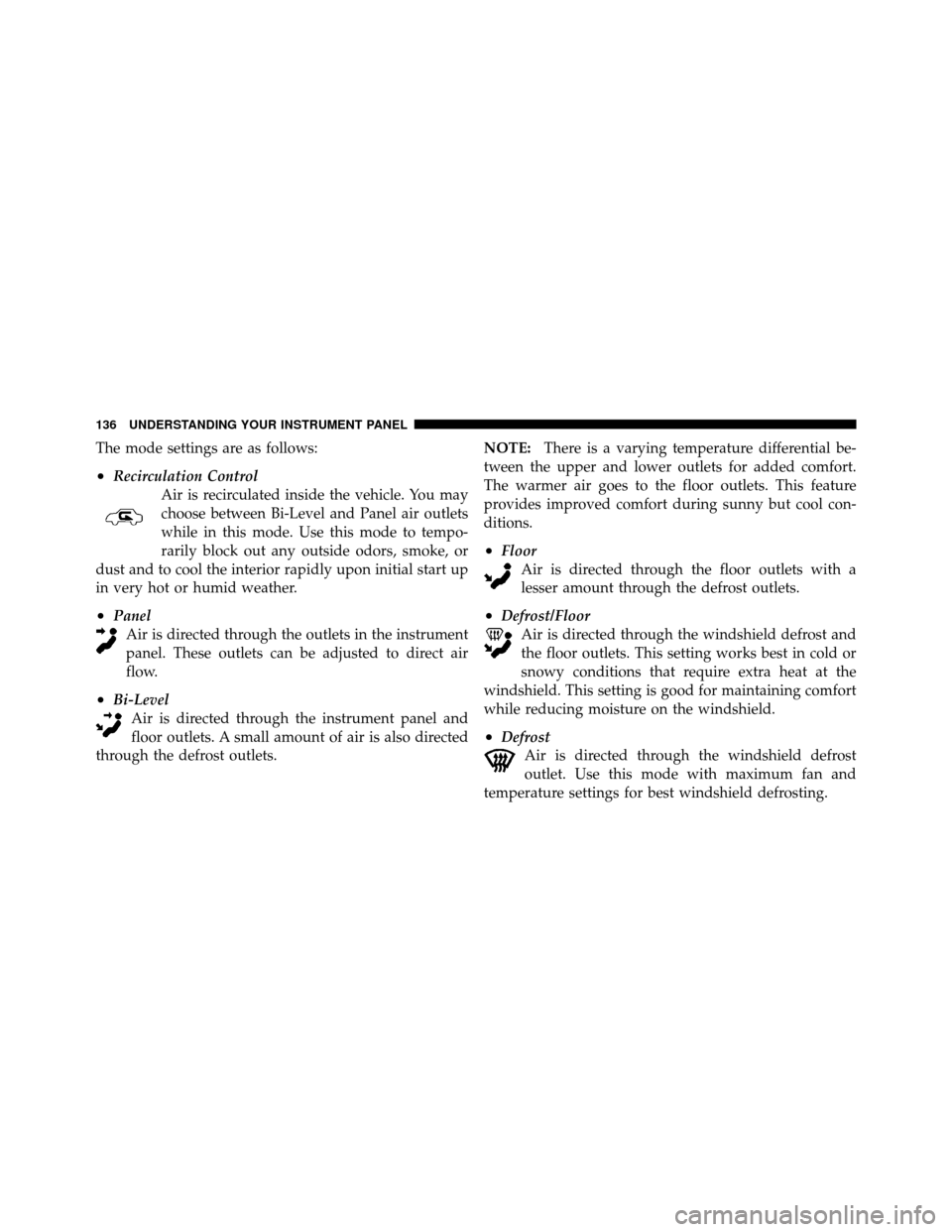Page 134 of 315

Electronic Serial Number/Sirius Identification
Number (ESN/SID)
The Electronic Serial Number/Sirius Identification Num-
ber is needed to activate your Sirius Satellite Radio
system. To access the ESN/SID, refer to the following
steps:
ESN/SID Access with RBB, RAH, REV and RBK
Radios
With the ignition switch in the ACCESSORY position and
the radio OFF, press the Tape Eject or CD “EJT” button
(depending on the radio type) and TIME buttons simul-
taneously for three seconds. The first four digits of the
twelve-digit ESN/SID number will be displayed. Press
the SEEK UP (+) button to display the next four digits.
Continue to press the SEEK UP (+) button until all twelve
ESN/SID digits have been displayed. The SEEK DOWN
(-) will page down until the first four digits are displayed.
The radio will exit the ESN/SID mode when any otherbutton is pushed, the ignition is turned OFF, or five
minutes has passed since any button was pushed.
ESN/SID Access with RBP, RBU, RAZ, RB1 and
RBQ Radios
With the ignition switch in the ACCESSORY position and
the radio OFF, press the CD Eject and TIME buttons
simultaneously for three seconds. All twelve ESN/SID
numbers will be displayed. The radio will exit the
ESN/SID mode when any other button is pushed, the
ignition is turned OFF, or five minutes has passed since
any button was pushed.
Selecting Uconnect™ Multimedia (Satellite) Mode
in RBB, RAH, REV and RBK Radios
Press the MODE button repeatedly until
�SA�appears in
the display. A CD or tape may remain in the radio while
in the Satellite radio mode.
130 UNDERSTANDING YOUR INSTRUMENT PANEL
Page 135 of 315

Selecting Uconnect™ Multimedia (Satellite) Mode
in RBP, RBU, RAZ, RB1 and RBQ Radios
Press the MODE button repeatedly until the word
�SIRIUS�appears in the display. These radios will also
display the following:
•After three seconds, the current channel name and
channel number will be displayed for five seconds.
•The current program type and channel number will
then be displayed for five seconds.
•The current channel number will then be displayed
until an action occurs.
A CD or tape may remain in the radio while in the
Satellite radio mode.
Selecting a Channel
Press and release the SEEK or TUNE buttons to search for
the next channel. Press the top of the button to search up and the bottom of the button to search down. Holding the
TUNE button causes the radio to bypass channels until
the button is released.
Press and release the SCAN button (if equipped) to
automatically change channels every seven seconds. The
radio will pause on each channel for seven seconds
before moving on to the next channel. The word
�SCAN�
will appear in the display between each channel change.
Press the SCAN button a second time to stop the search.
NOTE: Channels that may contain objectionable content
can be blocked. Contact Sirius Customer Care at 888-539-
7474 to discuss options for channel blocking or unblock-
ing. Please have your ESN/SID information available.
Storing and Selecting Pre-Set Channels
In addition to the 10 AM and 10 FM pre-set stations, you
may also commit 10 satellite stations to pushbutton
memory. These satellite channel pre-set stations will not
4
UNDERSTANDING YOUR INSTRUMENT PANEL 131
Page 136 of 315

erase any AM or FM pre-set memory stations. Follow the
memory pre-set procedures that apply to your radio.
Using the PTY (Program Type) Button
(If Equipped)
Follow the PTY button instructions that apply to your
radio.
PTY (SCAN) Button
When the desired program type is obtained, press the
SCAN button within five seconds. The radio will play
seven seconds of the selected channel before moving to
the next channel of the selected program type. Press the
SCAN button a second time to stop the search.
NOTE:Pressing the SEEK or SCAN button while per-
forming a music-type scan will change the channel by
one and stop the search. Pressing a pre-set MEMORY
button during a music-type scan, will call up the memory
channel and stop the search.
PTY (SEEK) Button
When the desired program is obtained, press the SEEK
button within five seconds. The channel will change to
the next channel that matches the program type selected.
Satellite Antenna
To ensure optimum reception, do not place items on the
roof around the rooftop antenna location or strap items to
the trunk lid around the trunk lid antenna (if equipped).
Metal objects placed within the line of sight of the
antenna will cause decreased performance. Larger lug-
gage items such as bikes should be placed as far rearward
as possible, within the loading design of the rack. Do not
place items directly on or above the antenna.
132 UNDERSTANDING YOUR INSTRUMENT PANEL
Page 137 of 315

Reception Quality
Satellite reception may be interrupted due to one of the
following reasons.
•The vehicle is parked in an underground parking
structure or under a physical obstacle.
•Dense tree coverage may interrupt reception in the
form of short audio mutes.
•Driving under wide bridges or along tall buildings can
cause intermittent reception.
•Placing objects over or too close to the antenna can
cause signal blockage.
RADIO ANTENNA
The radio antenna is located in the windshield.
CD/DVD DISC MAINTENANCE
To keep a CD/DVD in good condition, take the following
precautions:
1. Handle the disc by its edge; avoid touching the
surface.
2. If the disc is stained, clean the surface with a soft cloth,
wiping from center to edge.
3. Do not apply paper or tape to the disc; avoid scratch-
ing the disc.
4. Do not use solvents such as benzene, thinner, cleaners,
or anti-static sprays.
5. Store the disc in its case after playing.
6. Do not expose the disc to direct sunlight.
7. Do not store the disc where temperatures may become
too high.
4
UNDERSTANDING YOUR INSTRUMENT PANEL 133
Page 138 of 315
NOTE:If you experience difficulty in playing a particu-
lar disc, it may be damaged (i.e., scratched, reflective
coating removed, a hair, moisture or dew on the disc)
oversized, or have protection encoding. Try a known
good disc before considering disc player service.
RADIO OPERATION AND CELLULAR PHONES
Under certain conditions, the cellular phone being on in
your vehicle can cause erratic or noisy performance from
your radio. This condition may be lessened or eliminated
by relocating the cellular phone antenna. This condition
is not harmful to the radio. If your radio performance
does not satisfactorily “clear” by the repositioning of the
antenna, it is recommended that the radio volume be
turned down or off during cellular phone operation.
CLIMATE CONTROLS
The Air Conditioning and Heating System is designed to
make you comfortable in all types of weather.
Air Conditioning and Heating System
Air Conditioning And Heater Controls
134 UNDERSTANDING YOUR INSTRUMENT PANEL
Page 139 of 315
Blower Control
Use this control to regulate the
amount of air forced through the sys-
tem in any mode you select. Turn the
control clockwise to increase fan
speed. Turn the control to the O (Off)
position to shut off the fan and to
prevent any outside air from entering
the vehicle. This also turns off the A/C compressor.
NOTE: For vehicles equipped with Remote Start, the
climate controls will not function during Remote Start
operation if the blower control is left in the “O” (Off)
position.
Temperature Control
Use this control to regulate the tem-
perature of the air inside the passenger
compartment. The blue area of the
control indicates cooler temperatures
while the red area indicates warmer
temperatures.
Mode Control
Use this control to select the direction
of air flow.
NOTE: The dot between the mode control icons is a mix
position between the two modes.
4
UNDERSTANDING YOUR INSTRUMENT PANEL 135
Page 140 of 315

The mode settings are as follows:
•Recirculation ControlAir is recirculated inside the vehicle. You may
choose between Bi-Level and Panel air outlets
while in this mode. Use this mode to tempo-
rarily block out any outside odors, smoke, or
dust and to cool the interior rapidly upon initial start up
in very hot or humid weather.
•Panel Air is directed through the outlets in the instrument
panel. These outlets can be adjusted to direct air
flow.
•Bi-Level Air is directed through the instrument panel and
floor outlets. A small amount of air is also directed
through the defrost outlets. NOTE:
There is a varying temperature differential be-
tween the upper and lower outlets for added comfort.
The warmer air goes to the floor outlets. This feature
provides improved comfort during sunny but cool con-
ditions.
•Floor Air is directed through the floor outlets with a
lesser amount through the defrost outlets.
•Defrost/FloorAir is directed through the windshield defrost and
the floor outlets. This setting works best in cold or
snowy conditions that require extra heat at the
windshield. This setting is good for maintaining comfort
while reducing moisture on the windshield.
•Defrost Air is directed through the windshield defrost
outlet. Use this mode with maximum fan and
temperature settings for best windshield defrosting.
136 UNDERSTANDING YOUR INSTRUMENT PANEL
Page 141 of 315

NOTE:The air conditioning compressor operates in this
mode. This dehumidifies the air to help dry the wind-
shield. To improve fuel economy, leave in the Defrost
mode only when necessary.
Air Conditioning Control
With the fan control in the ON position, push the
A/C button to turn on the air conditioning com-
pressor. An indicator light above the button shows
that the Air Conditioning compressor is on. Conditioned
air is now directed through the outlets selected. Pushing
the button a second time turns the compressor OFF.
Slight changes in engine speed or power may be noticed
when the compressor is on. This is a normal occurrence
since the compressor will cycle on and off to maintain
comfort and increase fuel economy.
NOTE: If your air conditioning performance seems
lower than expected, check the front of the A/C con-
denser for an accumulation of dirt or insects.
Operating Tips
NOTE: Refer to the chart at the end of this section for
suggested control settings for various weather condi-
tions.
Summer Operation
The engine cooling system in air-conditioned vehicles
must be protected with a high-quality antifreeze coolant
to provide proper corrosion protection and to protect
against engine overheating. A solution of 50% ethylene
glycol antifreeze coolant and 50% water is recommended.
Refer to “Maintenance Procedures” in “Maintaining Your
Vehicle” for proper coolant selection.
Winter Operation
•
Use the Defrost mode to direct cold air away from the
occupants during engine warm-up in cold weather.
4
UNDERSTANDING YOUR INSTRUMENT PANEL 137